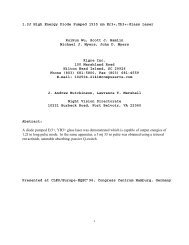Doped Phosphate Laser Glasses - Kigre, Inc.
Doped Phosphate Laser Glasses - Kigre, Inc.
Doped Phosphate Laser Glasses - Kigre, Inc.
Create successful ePaper yourself
Turn your PDF publications into a flip-book with our unique Google optimized e-Paper software.
Temperature, T, and corrosion rate, R, are related by the Arrhenius equation<br />
in the ideal case.<br />
Log R = C/T (3)<br />
In equation (3), C is a constant reflecting the activation energy of the<br />
corrosion process. Thus, an accelerated degradation test could be carried out<br />
by immersing strengthened cylinders into deionized boiling water for various<br />
times. Samples set in the boiling water for two hours exhibit similar thermal<br />
shock resistance. By measuring the weight loss, the corrosion rate in the<br />
boiling water was found to be 5xlO -5 g/cm.hour for QX/Er glass. This is equal<br />
to 160nm thickness per hour. According to equation (3), the corrosion rate at<br />
room temperature should be much smaller. This indicates that the surface<br />
compressive layer is quite stable. It should be noted that a small tension<br />
stress is built up in the interior of the rod when the compressive layer is<br />
formed on the surface. This tension stress would cause cracks in the rod when<br />
the surface compressive layer is removed.<br />
3. LASER PERFORMANCE TEST RESULTS AND DISCUSSION<br />
3.1 QX/Er Glass<br />
A high average output power test was performed utilizing a chemically<br />
strengthened 3mm diameter by 80mm long rod in a <strong>Kigre</strong> RFE-663 laser head. The<br />
resonator consisted of a flat high reflector and a flat output coupler with a<br />
reflectance of 85% at 1.54µm. The discharge pulse duration was 1.0ms. Figure<br />
4 illustrates the relationship between the laser output energy at 1.54µm and<br />
the input pump energy at a repetition rate of 10 Hz. A maximum average output<br />
power of 6.5W was achieved. Figure 4 shows that there is no obvious decrease<br />
of laser efficiency even when the lamp input power is greater than 1 kW.<br />
Q-switched laser testing was carried out using a rotating prism from a <strong>Kigre</strong><br />
KR-174 transmitter which is designed for flashlamp pumped eyesafe laser<br />
rangefinder. A 3mm diameter by 80 mm long QX/Er glass rod was employed. The<br />
thermal lensing in a high repetition rate Er:glass laser resonator will have a<br />
significant impact on the mode structure and polarization of the output. In<br />
order to operate in single mode, a specific resonator configuration has to be<br />
designed for each particular pump level. Various resonator configurations<br />
were designed and implemented according to the thermal lensing data generated<br />
for different pump energies and repetition rates. A single mode laser output<br />
of 5 mJ was achieved at 1.54µm with a 60ns pulse width at a repetition rate of<br />
15 Hz.<br />
Both the values of the maximum average output power and the repetition rate<br />
for Q-switched laser at 1.54µm represent an increase of several times<br />
comparedto previously reported Er 3+ glass lasers . The maximum input power was<br />
1kW for the high average power test and 300W for the high repetition rate Q-<br />
switched laser experiment. These values are still far below the maximum<br />
thermal loading capability of 1.5kW for such a chemically strengthened QX/Er<br />
glass rod. This indicates that better performance is achievable through<br />
improved laser designs.<br />
6

















